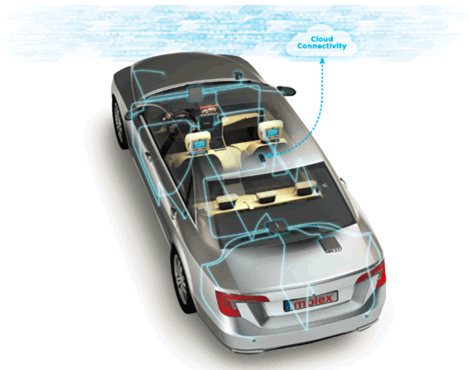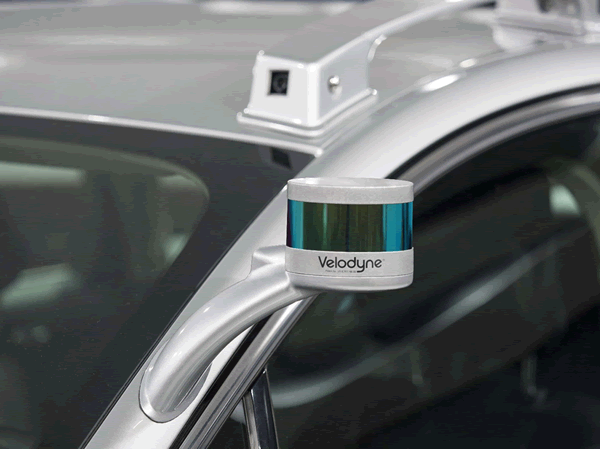No Drivers, Lots of Connectors – Autonomous Vehicles
Autonomous vehicles will need as many as 30 sensors, creating volumes of data. In-vehicle infotainment systems will further increase demand for high-speed networks.

Nissan autonomous car prototype (Norbert Aepli, Switzerland, CC BY 3.0, via Wikimedia Commons)
Self-driving cars are already on the roads. GM, Ford, Tesla Motors, Toyota, Volvo, Nissan, and other automakers are testing driverless cars and say they plan to release autonomous models within the next few years. Although the trial period is uncovering some serious issues that will need to be solved, the industry is expected to fine-tune autonomous vehicle technology, but not stop its momentum.
The race to enable autonomous driving is challenging suppliers throughout the electronics industry. A large number of sensors and very powerful controllers will be needed to make these vehicles safe and dependable, and most automotive planners foresee an expansion of infotainment options to satisfy passengers who don’t have to think about driving.
The Society of Automotive Engineers (SAE) has established a five-level scale that defines the different levels of driving automation, from level 0, in which a human driver is fully in control, to level 5, in which an autonomous system is fully in charge of driving. The levels in between describe varying degrees of assistance. Most of today’s vehicles are at level 1 or 2, and require full attention from drivers. Throughout the industry, suppliers are anticipating a rapid move to level 5 within the next few years. Each step upward on this scale puts more reliance on electronic controls, creating demands for high-reliability connectors.
“An autonomous level of five is a fully automated system that will require many additional cables and connectors,” said Alan MacDougall, advanced technology marketing manager at Molex. “As the level of autonomy increases, the fusion of multiple types of sensors such as cameras, radar, LiDAR, and infrared will increase the quantity of connectors and cables needed. Higher signal data rates will likely increase the need for additional connector shielding to meet signal integrity and EMI requirements.”

Advanced networks will create more demand for connectors.
Autonomous control systems will need as many as 30 sensors to gain the 360-degree view that’s needed to safely stop, turn, and switch lanes. The number of camera and radar systems will go significantly higher, and LiDAR will probably be used on most autonomous vehicles. LiDAR’s ability to add distance information to its camera data is seen as critical for many programs. These sensors will create a lot of data, pushing connector requirements upward.
“Our connectors need to deliver a high amount of data from the LiDAR unit, so finding connectors that meet those needs from a data rate perspective has been key,” said Anand Gopalan, chief technology officer at Velodyne LiDAR. “Depending on the customer, we have been asked for various connector form factors, as well as different positioning of connectors, mostly bottom versus side connectors.”

Velodyne’s LiDAR sensors will generate plenty of data.
The cameras used in these advanced vehicles will have higher resolution than those on today’s cars. Many system developers plan to use 8-megapixel cameras or higher, which will generate far more data than the 2-megapixel cameras now being used on new designs.
“In the past, we used low-speed connectors, but now that we’re dealing with high-definition video, we need automotive-grade connectors with very high frequency,” said Daniel Tsai, general manager of Jet Optoelectronics, an automotive electronic systems developer.
The considerable sensor content required by autonomous systems will generate gigabytes of data every second the car is active. That will drive high-bandwidth requirements and timing demands that today’s CAN networks can’t provide. Ethernet’s march from commercial to industrial environments will soon veer into the automotive industry.
“Ethernet could replace existing vehicle network protocols,” MacDougall said. “Higher sensor resolutions will require higher data bandwidth, an increase in the number of sensors, and the need for higher bandwidth for sensor aggregation through backbone cable. That could alter the supplier market. Many smaller suppliers couldn’t supplant Tier 1 and 2 suppliers that were well entrenched with their customers. But when things change, buyers often open up the market to all comers.”
“CAN has been around for 20 years, everyone is doing it, so we had no opportunity,” Tsai said. “With Ethernet, we have a lot of opportunities. We’re very interested in Ethernet Audio Video Bridging (AVB).”
Ethernet AVB, a set of extensions to the IEEE802.1 specifications that enables local Ethernet networks to stream audio and video data, may see its first applications in infotainment, which is expected to become even more important in driverless, passenger-exclusive vehicles. All the data being sent within the cabin and outside by sensor and control systems will create a lot of electromagnetic interference (EMI). Connector makers will play a key role in minimizing its impact. Many Taiwanese automotive suppliers have been focusing on electromagnetic controls.
“EMI requirements are now very strict,” said Jerry Lin, CEO of Jet Optoelectronics. “We need to see how we need to shield connectors and chips, so we just built an advanced EMI chamber.”

Jet Optoelectronics CEO Jerry Lin built an EMI chamber to meet changing automotive demands.
Companies like these are closely monitoring the challenges that are shaping the development of autonomous vehicles. Even while setbacks capture our attention, the companies that are working on the innovations to solve them continue to keep their attention on the road ahead.
Like this article? Check out our other Automotive and New Technology articles.
Recently posted:
[related_posts limit=”10″]
- State of the Industry: 2022-2023 Connector Sales - April 16, 2024
- Amphenol is On a Roll - April 2, 2024
- Nicomatic Proves That Two Heads are Better Than One - March 26, 2024





